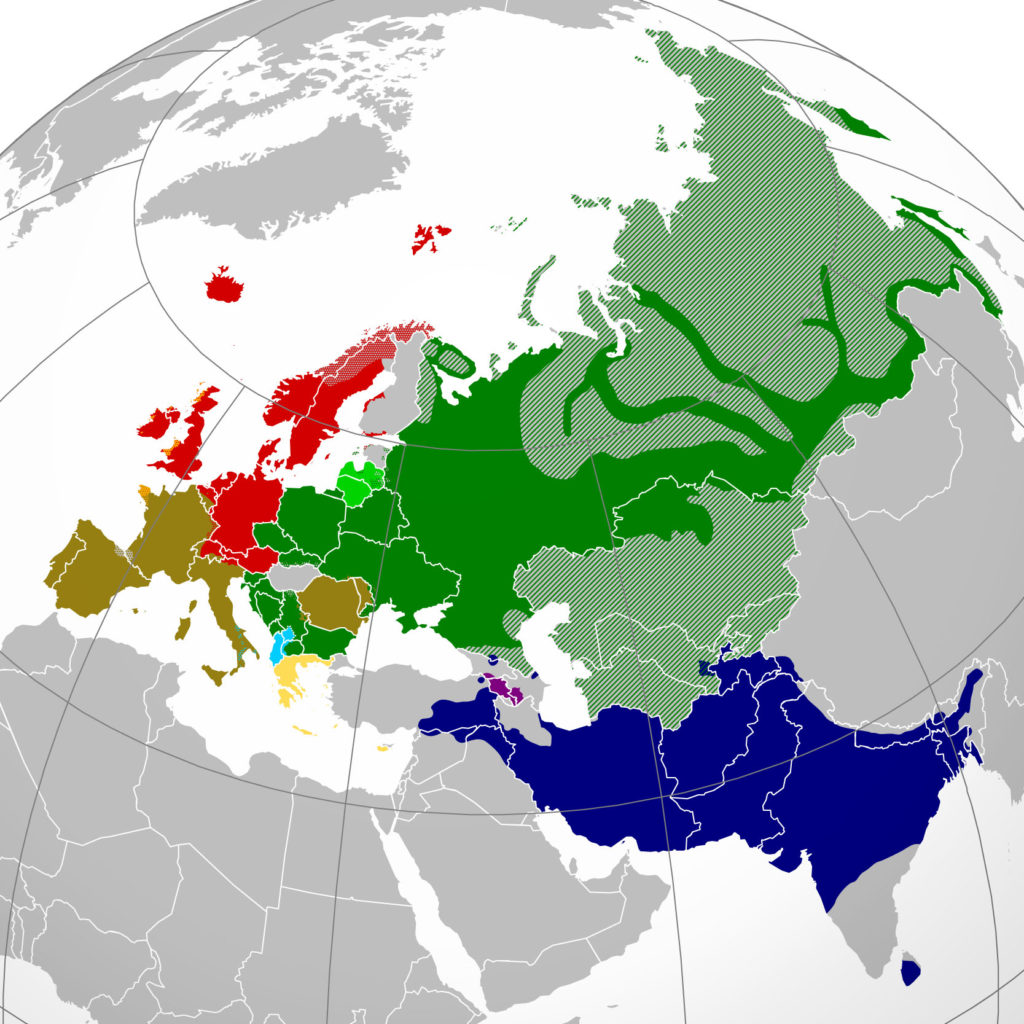When researching your genealogy, you will probably come across some reference to language at some point, either in the form of the languages your ancestors spoke, or the older language from which it was derived. One of the most well-known languages of the ancient world, to modern researchers, is the Indo-European language. It is so well-known to modern scholars because such a wide variety of languages we speak today have their origins in it. If you have ancestors from Europe or eastern Asia, their ancestors probably spoke Indo-European. Learning about this ancient language can help you better understand your own ancestors and the world in which they live, as well as give you an idea about your ancient origins and the lives of those distant people to whom you are so closely connected by DNA.

The first written evidence of the Indo-European language began appearing in records from the Bronze Age, which was from about 3300 to 1200 B.C. The language itself is derived from an even older language called Proto-Indo-European, which appears to have been spoken around the end of the last Ice Age, and of which no written records survive (though linguists have made attempts to reconstruct the language from the cultures, religions, and current languages spoken in the most isolated regions of where the Proto language would have been spoken). The earliest records in writing of Indo-European are written in Semitic Old Assyrian, Hittite, and Kultepe.
The discovery of the ancient Indo-European language started slowly in the 1500s, when visitors to India from Europe noticed similarities in the regional dialects there, as well as Iranian, with most European languages. A 1583 letter from a Jesuit missionary from Europe who went to India describes close similarities to the regional Indian dialects he encountered and the Greek and Latin languages. Another letter home from an Italian merchant in India in 1585 notes the similarities he perceived between some Sanskrit words and Italian words.
These early discoveries, and others like them, led linguists to determine that all of these diverse and quite different languages must have had a common ancestral language at one point. The idea of a common ancient language between Asian and European languages was first set to paper in 1647 when a Dutch linguist noted the similarities in many of these languages. He deduced that a number of Asian and European languages must have been derived from a common ancient language he dubbed Scythian.
Included in the languages with Scythian as a linguistic ancestor were: Dutch, Greek, Persian, Albanian, Latin, German, and the Celtic, Slavic, and Baltic languages. About twenty years later, a Turkish diplomat on a mission to Germany noted the similarities between the German and Persian languages. Others soon began making similar observations as travel to far-flung parts of the world became easier and more common with the discovery of the “New World” of North America.
About a century later, the first serious public lecture was given on this topic, with Sir William Jones noting the similarities between the three oldest known languages of the time—Sanskrit, Latin, and Greek. He also added Persian, Gothic, and Celtic to these languages, grouping them together with what he deduced must be a common ancient language that had since been lost to man. He did not give a name to the ancient language, but he did put its existence into the public discourse, and not just scholarly circles where it had previously resided.
The name for this ancient, common language was first used in 1813 by Thomas Young, a British physician, and polymath. Dubbing this common, ancient language Indo-European in one of his published papers, he derived the name from the farthest corners this ancient language supposedly reached. These borders are the areas where languages had thus far been found that all seemed to have commonalities in verb conjugation, structure of grammar, sounds of certain words, and more. The language is supposed to have been spoken from Western Europe to Northern India, and as far north as Germany.
Indo-European Studies began as a genuine academic discipline of its own between 1833 and 1852. Several books were published on this subject by academics over the next several decades, and a genealogy of languages from Indo-European was developed. It is interesting to think that languages can have a genealogy, just as people do. When you know more about your ancestry, you can then trace the genealogies of your ancestral languages to learn more about your ancient, pre-written, pre-historic ancestors and their lives in antiquity.
With Indo-European, it was once spoken by everyone in a single community. As people began traveling in groups out of this community, newer dialects based on the original language developed. When (and if) groups that traveled from the original community lost contact with each other, the dialects changed into whole new languages, but always with similarities to the original language, even if knowledge of the original language was lost. Groups that stayed in contact with each other may have developed regional dialects and sub-languages that were more similar to each other than of those in communities that lost contact with the other groups that traveled from the original community.
Because Indo-European was not the only ancient language, some changes in languages of groups that migrated can be attributed to language features of their new neighbors being incorporated into their original language. However, there are always enough similarities to the original language to identify it as Indo-European.
Indo-European languages eventually numbered in the hundreds, ranging from national languages to regional dialects. Many languages classified as Indo-European over the years have long since gone extinct, but plenty is still spoken around the world. These include almost all of the Indian dialects, as well as the Iranian ones, Eastern European languages including Russian, Slavic and Baltic languages, all the Romance languages (like Italian, French, Portuguese, Spanish, and Latin), Gaelic, Greek, and English, and more.






